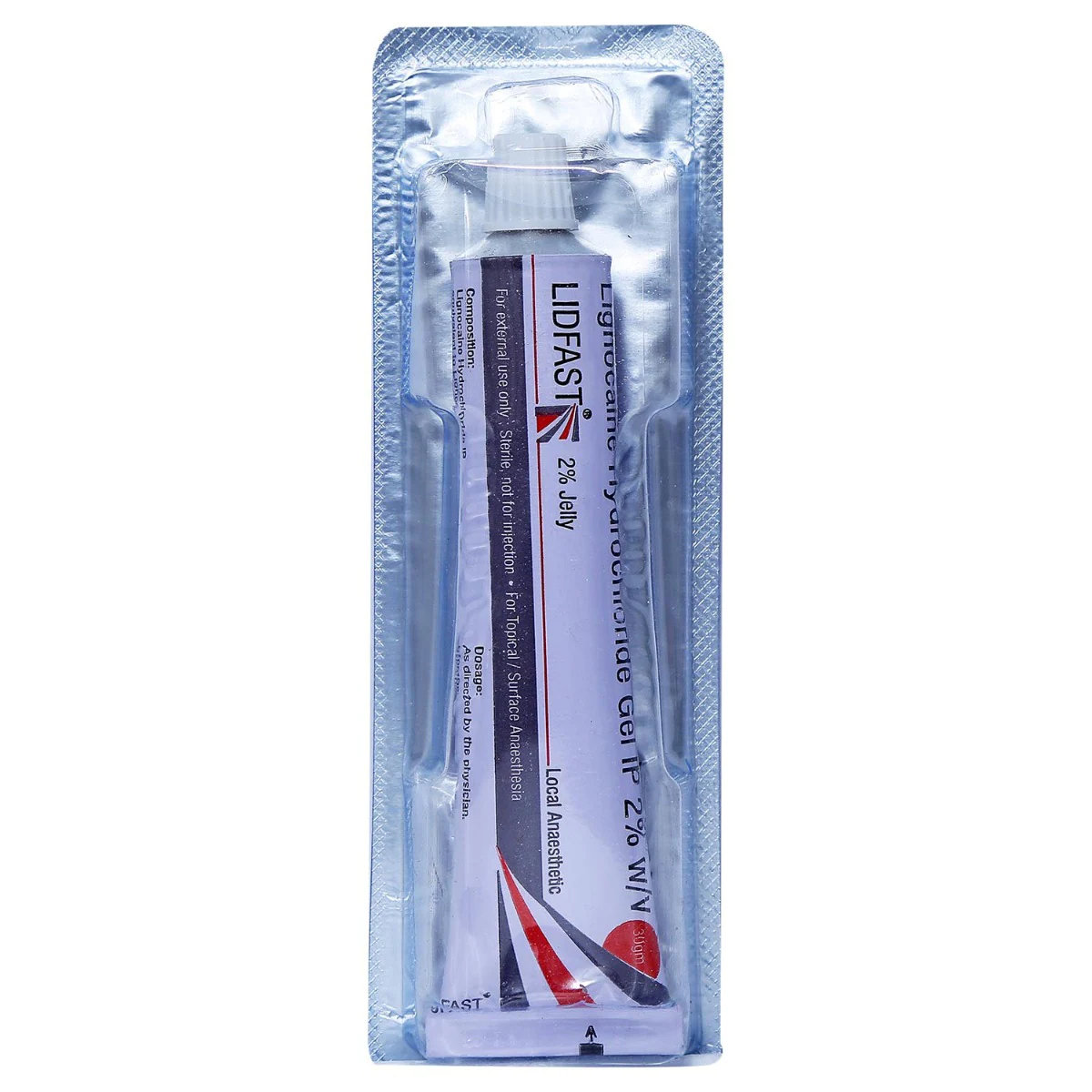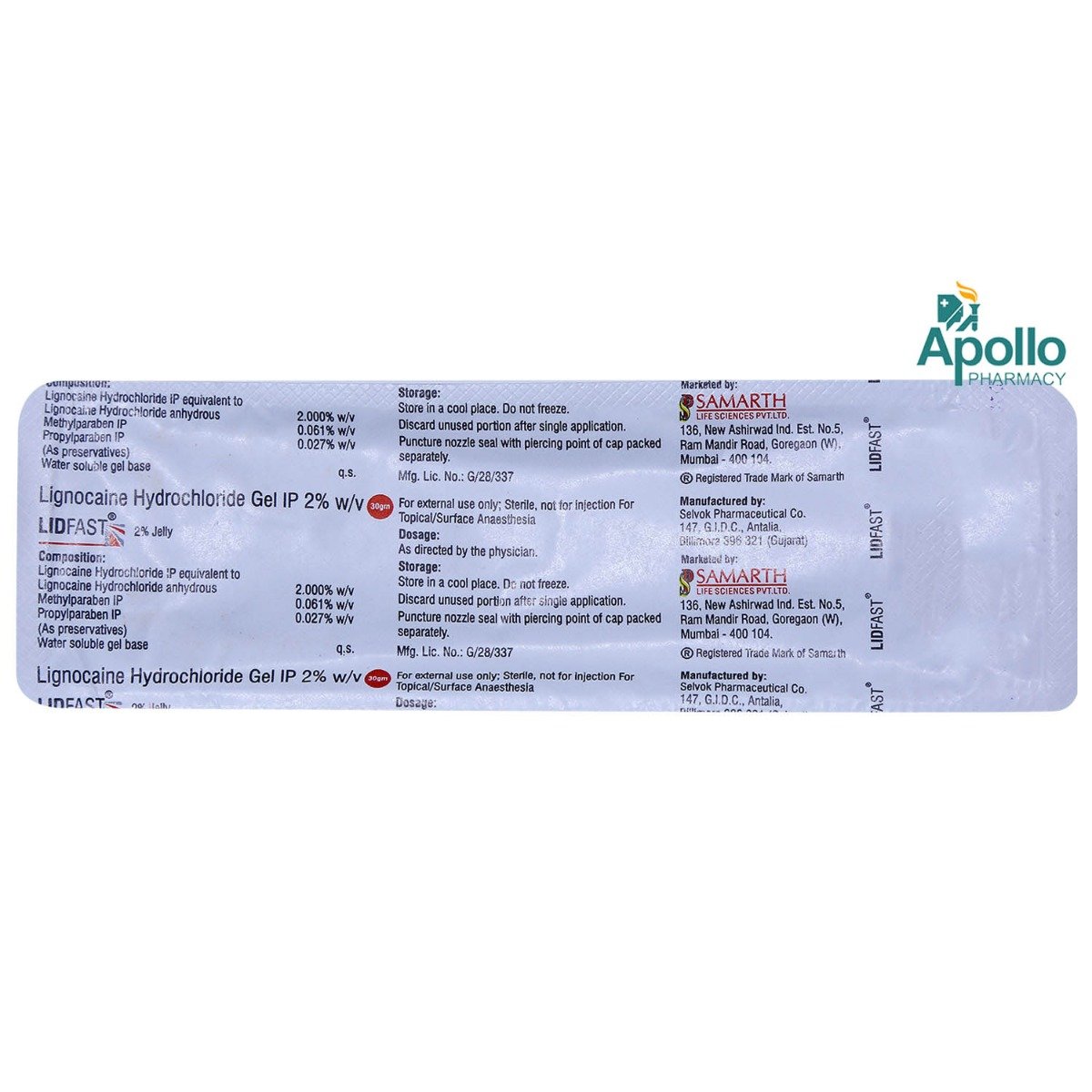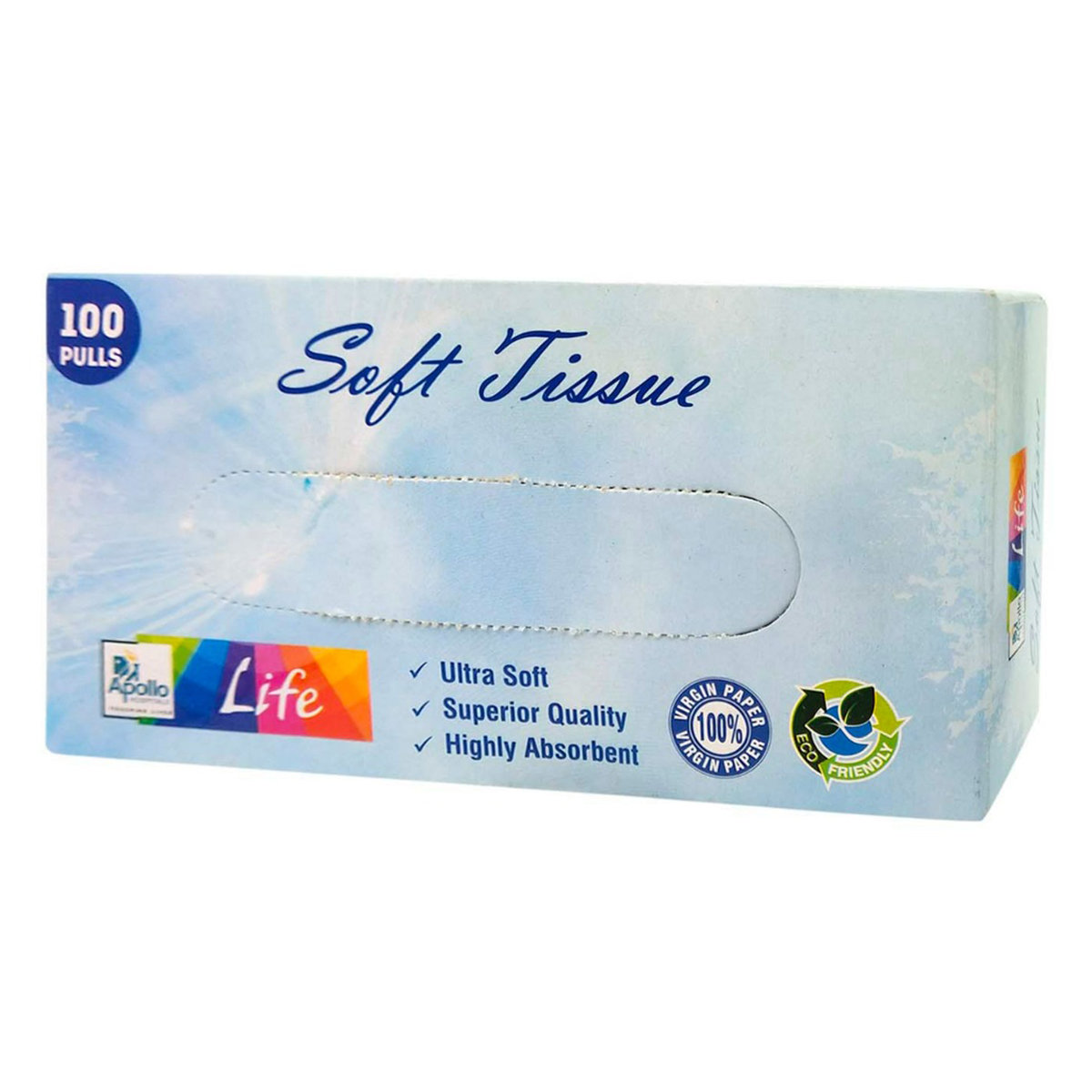Lidfast 2% Jelly 30 gm




MRP ₹34.5
(Inclusive of all Taxes)
₹4.1 Cashback (12%)
About Lidfast 2% Jelly
Lidfast 2% Jelly belongs to the class of local anaesthetics. It is a local anaesthetic used to numb certain body areas temporarily. On the other hand, it is used as an anaesthetic lubricant to insert instruments in the human body for medical procedures (e.g., catheters). It is also used to treat symptoms of painful inflammation of the urethra and bladder.
Lidfast 2% Jelly contains 'Lignocaine Hydrochloride'. It works by reducing pain sensation by working on peripheral nerves in the body.
Lidfast 2% Jelly should be used as directed by your physician. Generally, it is used before undergoing clinical procedures. Sometimes, Lidfast 2% Jelly may cause application site reactions such as a burning sensation, itching, redness, and irritation. Most of these side effects do not require medical attention and will resolve gradually over time. However, you are advised to talk to your doctor if you experience these side effects persistently.
If you are pregnant or breastfeeding, inform your doctor before using Lidfast 2% Jelly. It is not recommended for use in children as the safety data are not available. Avoid contact of Lidfast 2% Jelly with eyes, nose, mouth, swollen skin or open wounds. In case of accidental contact with these areas, rinse with water immediately.
Country of origin
Manufacturer/Marketer address
Online payment accepted

secured payment

india's most trusted pharmacy

genuine products
Composition :
Manufacturer/Marketer :
Consume Type :
Expires on or after :
Return Policy :
Available Offers
Provide Delivery Location
About Lidfast 2% Jelly
Lidfast 2% Jelly belongs to the class of local anaesthetics. It is a local anaesthetic used to numb certain body areas temporarily. On the other hand, it is used as an anaesthetic lubricant to insert instruments in the human body for medical procedures (e.g., catheters). It is also used to treat symptoms of painful inflammation of the urethra and bladder.
Lidfast 2% Jelly contains 'Lignocaine Hydrochloride'. It works by reducing pain sensation by working on peripheral nerves in the body.
Lidfast 2% Jelly should be used as directed by your physician. Generally, it is used before undergoing clinical procedures. Sometimes, Lidfast 2% Jelly may cause application site reactions such as a burning sensation, itching, redness, and irritation. Most of these side effects do not require medical attention and will resolve gradually over time. However, you are advised to talk to your doctor if you experience these side effects persistently.
If you are pregnant or breastfeeding, inform your doctor before using Lidfast 2% Jelly. It is not recommended for use in children as the safety data are not available. Avoid contact of Lidfast 2% Jelly with eyes, nose, mouth, swollen skin or open wounds. In case of accidental contact with these areas, rinse with water immediately.
Uses of Lidfast 2% Jelly
Key Benefits
Lidfast 2% Jelly is a pain reliever that is used during specific medical operations (such as putting a tube into the urinary system). It is also used to numb the lining of the mouth, throat, or nose prior to some medical operations (for example, intubation). Lidocaine jelly is also used to treat discomfort caused by urinary tract swelling (urethritis). It works by numbing particular moist parts of the body. Lidocaine is a kind of medication known as a local anesthetic. Lidfast 2% Jelly contains 'Lignocaine Hydrochloride,' which prevents sodium ions’ influx (entry) into the membrane covering the nerves, hence blocking impulse initiation and conduction.
Directions for Use
Storage
Side Effects of Lidfast 2% Jelly
- Burning sensation
- Itching
- Redness
- Irritation
Drug Warnings
Do not use Lidfast 2% Jelly if you are allergic to any of its components. Avoid using Lidfast 2% Jelly on larger skin areas or for a prolonged duration. Inform your doctor if you have methemoglobinemia (abnormal methemoglobin in the blood), heart, kidney or liver problems. Consult your doctor before using Lidfast 2% Jelly if you are pregnant or breastfeeding. Lidfast 2% Jelly is not recommended for children as safety and effectiveness have not been established.
Drug Interactions
Drug-Drug Interactions: Lidfast 2% Jelly may interact with other local anaesthetic and anti-arrhythmic drugs (tocainide, mexiletine).
Drug-Food Interactions: No interactions found/established.
Drug-Disease Interactions: Inform your doctor if you have methemoglobinemia (abnormal methemoglobin in the blood) or heart problems such as irregular heartbeat or heart block.
Habit Forming
Diet & Lifestyle Advise
- Maintain a healthy weight by performing regular low-strain exercises and eating healthy food.
- Get adequate sleep, as resting the muscles can help in reducing inflammation and swelling.
- De-stress yourself by meditating, reading books, taking a warm bubble bath, or listening to soothing music.
- Eat food rich in antioxidants such as berries, spinach, kidney beans, dark chocolate, etc.
- Foods containing flavonoids help in reducing inflammation. These include soy, berries, broccoli, grapes, and green tea.
- Avoid smoking and alcohol consumption.
Special Advise
- Do not apply Lidfast 2% Jelly on open wounds, injured skin, or unhealed shingles blisters.
- Wash your hands after use. However, do not wash your hands if you are using Lidfast 2% Jelly on your hands.
- If Lidfast 2% Jelly comes in contact with eyes, mouth or nose, wash with water immediately. Consult a doctor if irritation persists.
- Do not scratch or rub the skin when it is numb.
Disease/Condition Glossary
Pain: Pain alerts your nervous system that something is amiss. It is a painful sensation such as a prick, tingling, sting, burn, or aching. Pain can be either acute or dull. It might come and go or be continuous. You may have pain in one part of your body, such as your back, abdomen, chest, or pelvis, or you may experience pain throughout your body. Pain can be generalised (overall body aches) or localised (affecting a specific body area).
Local anaesthesia: It causes numbing/loss of sensation to a specific area of the body. It is used to treat or prevent pain during surgery or medical procedures.
Post-herpetic neuralgia: Post-herpetic neuralgia is a persistent discomfort associated with shingles. Shingle is a viral illness that causes painful rashes caused by the recurrence of chicken pox virus infection. Symptoms include nerve discomfort and itching.
FAQs
Lidfast 2% Jelly blocks the influx of sodium ions into the membrane that surrounds the nerves, thereby preventing the initiation and conduction of impulses (nerve signal). Hence, it provides an anaesthetic effect and decreases the sensation of pain.
Avoid concomitant use of Lidfast 2% Jelly with other topical products such as cosmetics, sunscreens, lotions, moisturizers, insect-repellent creams, and other gels.
Do not apply external heat or cover the treated skin with dressings after applying Lidfast 2% Jelly. Covering the skin or applying heat might increase the amount of drug absorbed into the skin leading to unpleasant side effects.
Do not apply Lidfast 2% Jelly on open wounds, injured skin, or unhealed shingles blisters. Apply Lidfast 2% Jelly on intact skin only.
Avoid using Lidfast 2% Jelly for longer durations unless prescribed by the doctor. If your condition does not improve even after using Lidfast 2% Jelly for seven days, consult your doctor.
Disclaimer
Customers Also Bought
Alcohol
Safe if prescribed
It is unknown if alcohol affects Lidfast 2% Jelly. Please consult your doctor if you have any concerns.
Pregnancy
Consult your doctor
Lidfast 2% Jelly should not be used when pregnancy unless clearly necessary. So, inform your doctor if you are pregnant or suspect pregnancy. Your doctor will weigh the benefits and potential risks before prescribing Lidfast 2% Jelly.
Breast Feeding
Consult your doctor
Let your doctor know if you are a nursing mother before taking Lidfast 2% Jelly; your doctor will decide whether breastfeeding mothers can take Lidfast 2% Jelly or not.
Driving
Safe if prescribed
It is not known if Lidfast 2% Jelly affects your ability to drive. Drive only if you are alert after using Lidfast 2% Jelly.
Liver
Consult your doctor
Limited information was available about the effects of Lidfast 2% Jelly in patients with liver disease. Inform your doctor before using the Lidfast 2% Jelly if you have a history of liver diseases. Your doctor will prescribe only if the benefits outweigh the risks.
Kidney
Consult your doctor
Limited information was available about the effects of Lidfast 2% Jelly in patients with kidney disease. Inform your doctor before using the Lidfast 2% Jelly if you have a history of kidney diseases. Your doctor will prescribe only if the benefits outweigh the risks.
Children
Safe if prescribed
Lidfast 2% Jelly is not recommended for children as efficacy and safety have not been established.
Author Details
We provide you with authentic, trustworthy and relevant information
Uses of Lidfast 2% Jelly
Key Benefits
Lidfast 2% Jelly is a pain reliever that is used during specific medical operations (such as putting a tube into the urinary system). It is also used to numb the lining of the mouth, throat, or nose prior to some medical operations (for example, intubation). Lidocaine jelly is also used to treat discomfort caused by urinary tract swelling (urethritis). It works by numbing particular moist parts of the body. Lidocaine is a kind of medication known as a local anesthetic. Lidfast 2% Jelly contains 'Lignocaine Hydrochloride,' which prevents sodium ions’ influx (entry) into the membrane covering the nerves, hence blocking impulse initiation and conduction.
- Tell your doctor if you notice any unusual symptoms after taking the medication, such as flat purple, or red spots on your skin.
- Your doctor may change your medication, lower the dose, or stop the treatment to help manage the symptoms.
- Avoid heavy physical activity and get plenty of rest to prevent further worsening of the symptoms.
- Apply cold packs to the affected areas for relief.
- Drink plenty of fluids to stay hydrated, and eat fruits and vegetables or take supplements to get enough vitamins.
- Over-the-counter pain relievers can help with discomfort.
- Regularly wash your hands with alcohol-based sanitizer or soap and water.
- Also, avoid sharing personal items like glasses or utensils with other individuals.
- Consult your doctor if you experience skin redness, itching, or irritation after taking medication.
- Your doctor may adjust your treatment plan by changing your medication or providing guidance on managing your erythema symptoms.
- Your doctor may recommend or prescribe certain medications to help alleviate symptoms.
- Apply cool compresses or calamine lotion to the affected skin area to reduce redness and itching.
- Stay hydrated by drinking plenty of water to help alleviate symptoms and keep your skin hydrated.
- Monitor your skin condition closely and promptly report any changes, worsening symptoms, or concerns to your healthcare provider.
- Apply a cold compress to the irritated area can help reduce redness and swelling.
- When applying medications that can cause irritation, switch up the application site each time to prevent excessive irritation in one area.
- Using a gentle, fragrance-free moisturizer can help keep the skin hydrated and reduce irritation.
- Wash the application site with mild soap and water before applying medication.
- Scratching can worsen irritation, so try to avoid scratching.
- Consult your doctor if you experience skin redness, itching, or irritation after taking medication.
- Apply cool compresses or calamine lotion to the affected skin area to reduce irritation.
- Stay hydrated by drinking plenty of water to help alleviate symptoms and keep your skin soothing.
- Monitor your skin condition closely and promptly report any changes, worsening symptoms, or concerns to your healthcare provider.
- Consult and seek guidance from a doctor or healthcare expert to determine the cause and best course of treatment.
- Avoid harsh products, extreme temperatures, and other potential irritants that may exacerbate the issue.
- Depending on the location and severity of the burning, your healthcare professional may recommend applying a soothing or protective agent, such as a cream, gel, or ointment.
- Keep the affected area clean to promote healing and prevent further irritation.
- Schedule follow-up appointments with your healthcare professional to monitor your symptoms and adjust your treatment plan as needed.
- If the burning or irritation persists or worsens, seek medical attention for further guidance and treatment.
- Reduce salt intake to minimize fluid buildup.
- Use compression stockings, sleeves, or gloves.
- Gently massage the affected area towards the heart.
- Protect the swollen area from injury and keep it clean.
- Use lotion or cream to keep the skin moisturized.
Directions for Use
Storage
Drug Warnings
Do not use Lidfast 2% Jelly if you are allergic to any of its components. Avoid using Lidfast 2% Jelly on larger skin areas or for a prolonged duration. Inform your doctor if you have methemoglobinemia (abnormal methemoglobin in the blood), heart, kidney or liver problems. Consult your doctor before using Lidfast 2% Jelly if you are pregnant or breastfeeding. Lidfast 2% Jelly is not recommended for children as safety and effectiveness have not been established.
Therapeutic Class
Drug-Drug Interactions
Drug-Drug Interactions
Login/Sign Up
Diet & Lifestyle Advise
- Maintain a healthy weight by performing regular low-strain exercises and eating healthy food.
- Get adequate sleep, as resting the muscles can help in reducing inflammation and swelling.
- De-stress yourself by meditating, reading books, taking a warm bubble bath, or listening to soothing music.
- Eat food rich in antioxidants such as berries, spinach, kidney beans, dark chocolate, etc.
- Foods containing flavonoids help in reducing inflammation. These include soy, berries, broccoli, grapes, and green tea.
- Avoid smoking and alcohol consumption.
Habit Forming
Side Effects of Lidfast 2% Jelly
- Burning sensation
- Itching
- Redness
- Irritation
Special Advise
- Do not apply Lidfast 2% Jelly on open wounds, injured skin, or unhealed shingles blisters.
- Wash your hands after use. However, do not wash your hands if you are using Lidfast 2% Jelly on your hands.
- If Lidfast 2% Jelly comes in contact with eyes, mouth or nose, wash with water immediately. Consult a doctor if irritation persists.
- Do not scratch or rub the skin when it is numb.
Disease/Condition Glossary
Pain: Pain alerts your nervous system that something is amiss. It is a painful sensation such as a prick, tingling, sting, burn, or aching. Pain can be either acute or dull. It might come and go or be continuous. You may have pain in one part of your body, such as your back, abdomen, chest, or pelvis, or you may experience pain throughout your body. Pain can be generalised (overall body aches) or localised (affecting a specific body area).
Local anaesthesia: It causes numbing/loss of sensation to a specific area of the body. It is used to treat or prevent pain during surgery or medical procedures.
Post-herpetic neuralgia: Post-herpetic neuralgia is a persistent discomfort associated with shingles. Shingle is a viral illness that causes painful rashes caused by the recurrence of chicken pox virus infection. Symptoms include nerve discomfort and itching.
All Substitutes & Brand Comparisons

Have a query?
Buy best Anaesthetics products by
Neon Laboratories Ltd
Themis Pharmaceutical Ltd
Troikaa Pharmaceuticals Ltd
Samarth Life Sciences Pvt Ltd
Abbott India Ltd
Astra Zeneca Pharma India Ltd
Baxter India Pvt Ltd
Core Claris Lifesciences Ltd
Celon Laboratories Pvt Ltd
Ajanta Pharma Ltd
Miracalus Pharma Pvt Ltd
Torrent Pharmaceuticals Ltd
Zydus Cadila
AP Pharmaceutical
Fresenius Kabi India Pvt Ltd
Galpha Laboratories Ltd
Indoco Remedies Ltd
Anglo French Drugs & Industries Ltd
B Braun Melsungen AG
Cadila Pharmaceuticals Ltd
Claris Lifesciences Ltd
Dr Reddy's Laboratories Ltd
Elder Pharmaceuticals Ltd
Fortel Life Sciences
Hetero Healthcare Pvt Ltd
Icpa Health Products Ltd
Pure Derma Healthcare Pvt Ltd
Salve Pharmaceuticals Pvt Ltd
Sunways (India) Pvt Ltd
VARENYAM HEALTHCARE PVT LTD
Wockhardt Ltd
Zydus Healthcare Ltd
6Ipain Healthcare Pvt Ltd
Admac Lifesciences(Oncology)
Aesmira Lifesciences Pvt Ltd
Albatross Healthcare Pvt Ltd
Amwill Healthcare Pvt Ltd
Anchal Life Science Pvt Ltd
Atopic laboratories Pvt Ltd
Biovenice Criticure
Cellgen Biopharma
Cipla Ltd
Delvin Formulations (P) Ltd
Entod Pharmaceuticals Ltd
Ethinext Pharma
Foremost Marketing Pvt Ltd
Fusion Health Care Pvt Ltd
German Remedies Ltd
Global Dent Aids Pvt Ltd
Greycells Lifesciences Pvt Ltd
Himeros Pharmaceuticals Pvt Ltd
Ici India Ltd
Icpa Lab
Ikon Remedies Pvt Ltd
Intas Pharmaceuticals Ltd
Kopran Laboratories Ltd
Kshipra Health Solutions
Leeford Healthcare Ltd
MSP Pharmaceuticals
Medimarck Biotech
Modi Mundipharma Pvt Ltd
Mylan Pharmaceuticals Pvt Ltd
Optima Healthcare Solutions
Pericles Pharma
Pharmadent Remedies Pvt Ltd
Piramal Enterprises Ltd
Pristine Pearl Pharma Pvt Ltd
Questus Pharma Pvt Ltd
Ranbaxy Laboratories Ltd
Rusan Healthcare Pvt Ltd
Scott Edil Pharmacia Ltd
Skinocean Pharmaceuticals
Themis Chemicals Ltd
Themis Medicare Ltd
Ultra Drugs Pvt Ltd
Vhb Life Sciences Inc
Zee Laboratories Pvt Ltd















